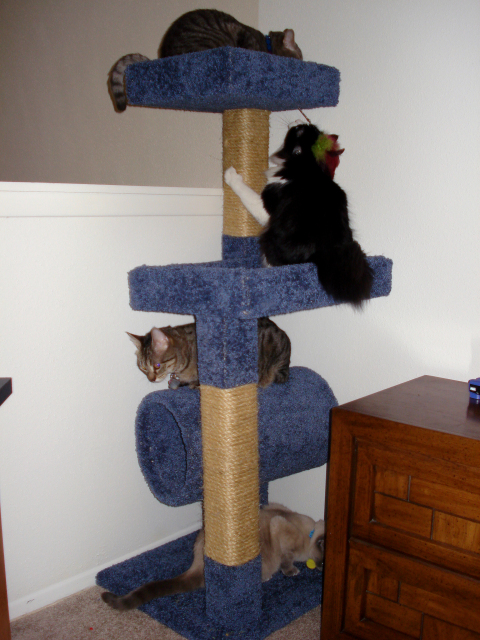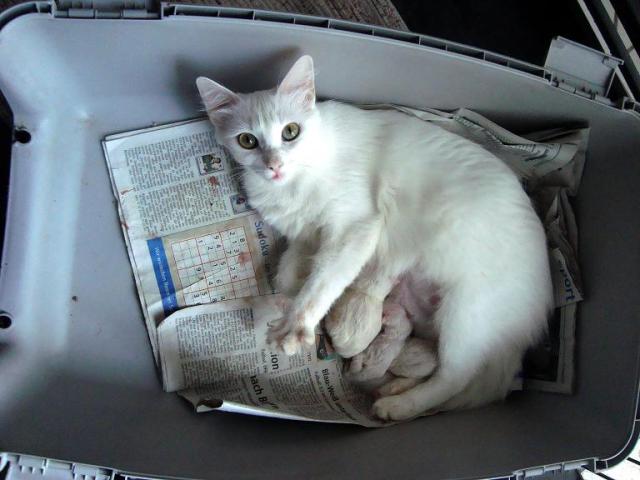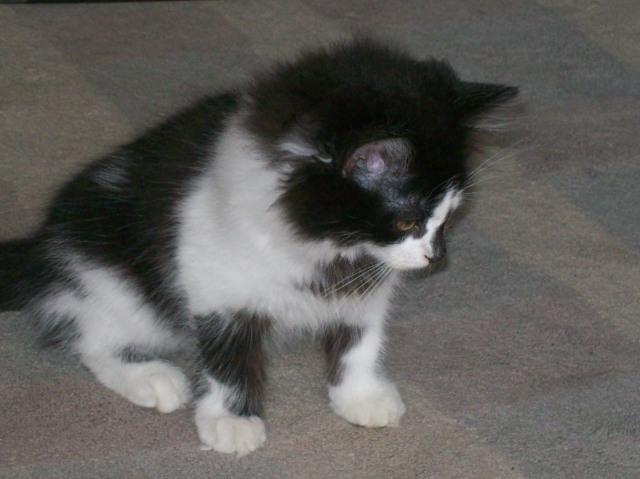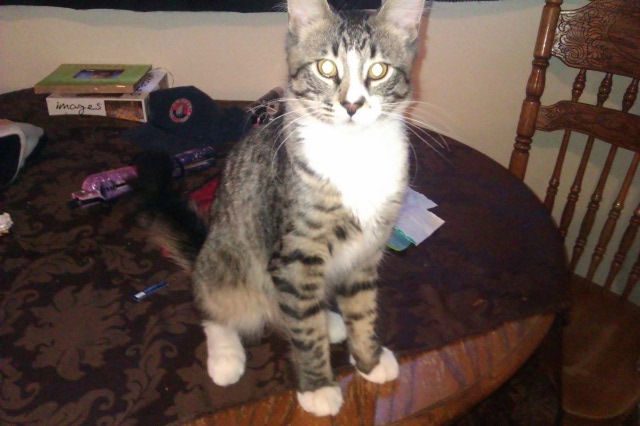QuestionHi!
I recently acquired a tortie; although I wasn't sure I would keep her I couldn't let her previous owner take her to the SPCA on Christmas Eve, so I've only had her 3 months. They had 2 cats; 2 torties, the one I took is a mature 7 year old declawed and spayed (so indoor only). She is a loving, affectionate, well behaved, confident, expressive and fun kitty. She is territorial; she fights through the glass window with the neighborhood cats and is constantly irritated by their presence. She was fighting with the 2nd cat in her previous home and they elected to keep that cat. I am her 3rd or 4th 'person' from what I can tell. My challenge; I'd like to get a dog (again) for a hiking and running companion. I'd prefer to rescue a mature dog from a rescue / foster organization. My question is how do I assess whether this cat can adapt to another species with her history of not accepting another animal? I can work with the dog rescue to cat test any prospective dog however i am not sure this cat will ever accept not being an only. I understand Torties have reputations for ineresting personalities; can you help me reach a realistic expectation around this? Thanks!
Answer
 Phoenix, Evo, Luna, &
Phoenix, Evo, Luna, &
Hi,
It's wonderful that you have rescued a cat, but are willing to rescue a dog as well, and understand the importance of matching personalities and energy levels. In my experience, indoor cats become territorial when they are unhappy and/or bored. Nothing against you, but it is common among cat owners that they don't quite understand feline behavior and needs, and expect them all to be independent and not need much companionship. I have found that this couldn't be further from the truth. I have six cats, and have raised them all to be social with me, strangers, kids, as well as other animals and in different environments other than home.
I would start with spending a little quality time with your cat each day to try to strength the bond/relationship you have with her. Animals that have been from home to home are slower to trust and thereby slower to feel secure and safe in their current environment. She seems to be sensitive and touchy, and feels threatened even by passing animals outside. This could be a result of the animosity she felt toward the cat in her previous home. What toys and/or furniture does she have? Does she have a scratch post? If so, how tall and what material? I always start with the basics to try to make sure a cat is fulfilled. What food are you feeding her? Do you leave it out (free-feed) or feed her at certain times of the day? Do you call to her and praise her when she gives you eye contact and/or responds to her name? Very simple things will help to form a better relationship and enable her to trust you more. Each cat has their own likes and dislikes, and favorite toys.
Now seeing as how I don't know the answers to these questions, I'm just going to advise you in general assuming none of them are in place. Start with a good, holistic food. I'm not sure if you've heard of HALO, but I highly recommend checking out their website and reading why their food is above and beyond any other. Most people are unaware of the dangers of commercial pet food (pretty much any food that does not say organic or holistic on the bag) which are primarily that these companies continue to make these pet foods with dyes, chemicals, and preservatives that have been *proven* to cause cancer, Diabetes, Hyperthyroidism, urinary blockages, and a variety of other conditions ailing our pets and leading them to an early grave. Please see the following articles for more detailed information:
What's Really in Pet Food?
http://www.bornfreeusa.org/facts.php?more=1&p=359
Gluten and Toxins in Pet Food
http://www.celiac.com/articles/1129/1/Gluten-and-Toxins-in-Pet-Foods-Are-they-Po...
Is Coat Color Linked to Temperament?
http://www.messybeast.com/colour-tempment.htm
Once you have that covered, make sure you are not free-feeding, as this leads to early deterioration of organs as well as obesity. Unfulfilled cats will eat because they are bored, unhappy, stressed, or even just because it's there, which is very unhealthy. Furthermore, having consistent feeding times builds trust as well as strengthens your bond because you are providing them with one of their needs. They associate you with their food, which is always a positive thing. Next, make sure you are using an appropriate litter, preferrably a natural alternative such as wheat or pine. I switched mine to Swheat Scoop and could NOT be happier. The wheat is an agricultural byproduct of harvesting wheat for human consumption, and is chopped up to use as litter, reducing agricultural waste. It makes for a wonderful litter because their are no harmful chemicals such as sodium bentonite found in clumping clay litter which causes respiratory distress from the dust as well as is harmful to their digestive systems when they groom the residue from their paws. It can solidify in their intestines and kill them in worst case scenarios. Next, make sure that she has an upright sisal rope scratch post. Next, make sure that you have both toys she can play with alone such as toy mice or waded up paper balls as well as some with you, such as a leather tassle cat dangler.
Also be aware that some of the behavioral problems you are seeing are due to her being declawed. I understand you rescued her that way, but declawing is the surgical removal of their first metacarpal joint, not just the claws. As cats walk on their toes, walking in general is forever painful for them. Different cats exhibit different behaviors, but more dominant personalities usually fair the worst, becoming resentful and acting out aggressively with most anything they come into contact with. Cats are most commonly surrendered to shelters due to elimination issues or behavioral/aggression issues stemming from being declawed, as was apparently the case here. Because declawing can't be undone, there is only so much behavioral modification you can do depending on the individual cat as well as your level of commitment and patience. Since she holds such resentment towards both people and the cat she lived with, she would most likely project these feelings onto whatever animal is in the household. If they did not have a dog, it's possible she would respond better to a dog than a cat since she would have no preconceived notions or feeling about one, however you will still have to take great care to find one with a calm demeanor that is either respectful of cats, or you must be committed to introducing them slowly and properly so that you can teach the dog proper etiquette around the cat.
Once you feel you have formed a better bond with your cat and that you are ready, start looking for a compatible dog. The dog of course must first fit your needs and lifestyle and then her temperament. I assume you are looking for a medium-to-large sized dog since you are looking for a hiking/running companion. It seems your ideal match would be a dog with a low energy level with a medium to high activity level, and yes--the two are different. Also, have you ever had a dog before? If not, there are several more things I would like to go over with you to make sure you start your relationship with the dog off right. It is SOO important for you to be calm and establish your role as the leader *from the beginning*, and yes, this means when you meet the dog at the shelter.
Another common misconception is that people think the dog will behave the way it did in its cage at the shelter when they get it home. Animals at the shelter are scared and stressed, and each individual will respond to that in different ways. For example, just because a dog is sitting in its cage quietly doesn't mean you won't get it home and it won't bark at everything in sight. It can be difficult to accurately and objectively observe personality at the shelter, so the best thing to do is look at as many facts as you can and learn the history of the animal. Let the animal tell the story. I can't tell you how many times we have people surrender animals and lie about the reason why, and then they drastically reduce the chances of that animal finding the right home because they couldn't own up to the real reason they were surrendering it. For example, if the dog bit their child, they may surrender it and say it was because the child was allergic or they found it as a stray because they think the shelter will automatically put the dog down if they tell them that. On the opposite end, they may say the dog bit their child and was too aggressive, when what really happened is that they weren't supervising the dog with the child, the child yanked its tail, and it turned around and gave a warning bite or nip that didn't even draw blood, and then they surrender the dog labeling it as 'aggressive'. I could go on and on about these things. That is why when I worked in a shelter, I used my attention-to-detail and experience with behavior to make my own assessment of each animal, and they usually tell you the real story. Another perfect example is that an animal obviously wasn't a stray when it comes in well-groomed, free of fleas, and with clean ears. So instead of giving us a personality profile and history on the animal, they just say it was a stray and make it that much harder for us to learn about the animal and thereby place it in the most suitable home.
Before you get a dog, regardless of whether or not you have had one in the past, I *highly* recommend Caesar Millan's book Be the Pack Leader. You can get it at Barnes & Noble, Half Price Books, or even Amazon for about $10, and read it in about 3 hours or so. You will be amazed at how many mistakes and faulty assumptions humans make about dog behavior and their needs as a species.
At any rate, let me add this. Yes, it is true that people should do some research about breeds so that they know very important details about their traits and characteristics, however, each dog (animal) is an individual, so the primary things you should look for are personality and activity level and then know a bit about the breeds they're mixed with. A perfect example would be an Australian Cattle Dog mix. They were bred to heard and heel, and a lot of people would not know or understand this behavior and label it as aggression or biting. The way to curb this is to channel it into a positive activity. I have an Australian Cattle Dog mix, which I did not know at the time, and when I was 16 and observed her tendency to heel, I decided to teach her to play soccer in the backyard. I reinforced her to herd the soccer ball, and thereby redirected the behavior so that she did not do this with people. Furthermore, the breed does not drink much water, as they are an Australian breed. They obviously need water after exercise or heavy exertion, so I taught her the 'water' command and made her drink a certain amount of water right after we came in from a walk to ensure she stayed hydrated. Other people might think something was wrong with the dog and take in for unnecessary and expensive testing. These are just a few examples.
I'm sorry, I know this is getting lengthy, but this question is right up my alley, so to speak. Okay, basics of selecting a dog. Rule 1: Do NOT go on looks first. While everyone has their own personal preference, personality, energy level, activity level, and any specific special needs of the dog should be your first considerations. So start with looking at dogs that are about the size you are looking for. Rule 2: Do not judge a dog based on how it acts in the cage. Most shelters will let you take them out on the leash. Rule 3: When you first meet a dog, do not make direct eye contact, squat down to their level, turn your head a little to the side, and let them smell you. Dogs experience things through their nose first. If when you make eye contact, the dog meets your gaze and starts barking at you, even if his tail is wagging, he is dominant and you should move on. Tail wagging does not always mean they're happy--the position of the tail and the degree of the wag tells the story. I high, upright tail means dominance and possibly a challenge, a low or tucked tail means timidness and insecurity, a mid-level, side-to-side wag usually means a relaxed 'I'm happy to see you'. Now, while you are free to pick whichever personality you like, keep in mind a dominant dog is going to be harder to train, more stubborn, and less likely to respect the cat. If you are willing to take on a timid dog, please be aware that good people with the best intentions can ruin a timid dog by reinforcing their negative energy instead of helping them to become more relaxed and confident. For example, petting a dog with a low wagging tail and a lowered head means you are reinforcing that state of mind. The best way to help a timid animal is by your calm energy. Just your presence and energy helps a dog--people commonly wrongly assume you have to touch an animal to have an interaction with it or influence its mind.
For me, eye contact is important. Don't make eye contact first, let them look at you. This alone will tell you a lot about their personality. I also look for a connection. Some you have an almost instantaneous connection with, but remember to be objective. This is an important, 10-15 year commitment. I always recommend visiting with *at least* 3 different animals--the more you visit with, the better of a feel you get for different personalities, energies, and how you truly feel about each. Rule 4: Don't let the story outweigh your objectivity. Just because an animal has a sad story doesn't mean you need to adopt it--actually to the contrary--the saddest stories get the most attention, and thereby have the best chance at finding a good home. I always keep my eye out for overlooked animals. Also to that end, I try to stay away from popular breeds and ages, such as Labs, German Shepherds, any dog that looks purebred, and puppies in general.
Whichever dog you choose to visit with first, don't spend time petting or talking to it. Get it on the leash, hold it with some slack so that it's not tense, and walk forward with confidence and purpose until you are in a semi-private area. Then spend a little time petting the dog and observing its demeanor. My best recommendation would be to see if the shelter will get another dog out on a leash and just walk by at a distance (not let them meet). Then you can observe his behavior with other dogs. Does he stiffen, does his tail go up, does he stare the dog down, or does he just sit there relaxed and focus on you? If the animal has a foster, you will usually get a lot more detailed information about their personality and how they did in the fosters home with different animals. Then, you can see if there's a room in which the dog can see a cat (while on leash always) and observe his reactions. The key here is NOT to introduce animals face-to-face, as this is irrelevant, but to observe the dog's behavior in a variety of different situations.
It is my long held opinion that animals will adjust and acclimate to each other so that they can live in the same home if they are introduced slowly and properly, and the owner is responsible, patient, and consistent. Too often animals are misunderstood, mislabeled, mishandled, and/or the owner doesn't ensure that everyone in the household is consistent. For example, I have a dog, six cats, a bearded dragon, and a hamster. My oldest cat Indy is not very social and doesn't much care for any of my other cats, but I have a strong and unique relationship with each of my animals, and they trust me. When I first introduced them, I taught the younger the proper way to behave and ensured they learned proper social etiquette before ever leaving them together unsupervised for any amount of time. There is no chasing or stalking behavior aloud unless it is play and both parties are willing to play. I do this by teaching each of my cats the 'shhht' command, which is really nothing more than a short and sharp sound in a stern tone. It is the way I communicate to them that what they're doing is unacceptable and they have to stop. So while Indy doesn't really like the other five, she coexists with them just fine in a 900-sq-ft townhome. Furthermore, Luna, my Manx/Maine Coon bobtail, was picked up by a Rottweiler when she was 4 weeks old and lived to tell the tail. She of course was terrified of dogs, but I spent the first three months I had her developing a strong relationship based on trust and respect. I taught her commands with both verbal and hand cues, tricks, and groomed her and played each day. I also practice the tricks at feeding time. Then when she was four months old, I started introducing her to my dog. First just by smell, then sight, then close proximity, then being in the same room together, etc. They had about 10 minute interactions every week or so for about two months, then more frequently the last month. I would have Luna in my bedroom on the bed so she felt more secure, and let Nikki (my dog) in the room on leash. I would sit in between them closer to Luna and just have Nikki lay in the room at first. Eventually I got her closer and closer until I could let Luna sniff her without them being face to face. Then they were face to face, and after that, I could have them in the same room together. Of course, this worked the way it did because Nikki was raised with a cat since she was 9 weeks old, and was taught proper cat etiquette by me and him. She has always been respectful of giving an animal space when they hiss or get nervous, and never would approach in an excited way.
This is basically the slow and sometimes painstaking process you would go through with them. Of course, when first getting another animal, you should keep the resident animal in its own safe space/room and let the new animal adjust for at least a week. Get the dog on a normal schedule, feeing and exercise routine, and develop a bond before you even begin the slow introduction process. After a week, place a towel where both animals like to sleep and then switch them so that they get used to each others smell before they even meet face-to-face. After a few days of sleeping with the other towel, let them merely see each other at a distance. Keep this short and brief, and make sure to end on a positive note. Then, let the dog meet the cat when the cat is somewhere up at the dogs height and the dog is on a strong leash. There will be hissing and growling, and it's important not to scold the cat. She is only saying 'I'm uncomfortable' or 'I don't trust you'. If you don't already have one, I highly recommend a tall cat tower with at least one section where she can hide as her safe place. If you place this by a window where it get some sun and spray a little catnip, this will be her new favorite place. I am attaching a picture of the one I got for my cats for Christmas of 2007 complete with sisal posts and all. This will take time, but the slower you make the process, the easier it is on both. Start with letting them be in the same room and get accustomed to each others' smell and presence before allowing them both to be together in the house.
I hope all this helps and I didn't droll on too long, lol. I have a curse of being too thorough sometimes. I wish you the best of luck, and please email me at holly06petlover@yahoo.com if your interested in more tips and information on how to select a good dog food, best pet products, things vets won't tell you, etc. and so on. Have a great weekend!
Best regards,
Holly Martin
Introductions


 blackened area under lower jaw
Question
Daisy
My Daisy is a 12 year old short-h
blackened area under lower jaw
Question
Daisy
My Daisy is a 12 year old short-h
 Cat and Dog Introductions
QuestionHi!
I recently acquired a tortie; although I wa
Cat and Dog Introductions
QuestionHi!
I recently acquired a tortie; although I wa
 Feline Nutrition
QuestionQUESTION: I also rescue feral cats and kittens
Feline Nutrition
QuestionQUESTION: I also rescue feral cats and kittens
 handling my 9 week ferel kitten
QuestionMillie
QUESTION: Hi. My lovely 9 week ki
handling my 9 week ferel kitten
QuestionMillie
QUESTION: Hi. My lovely 9 week ki
 What Breed Is My Cat ??
Question
Cloud1 Cloud2
Hey, my boyfriend a
What Breed Is My Cat ??
Question
Cloud1 Cloud2
Hey, my boyfriend a